Back number
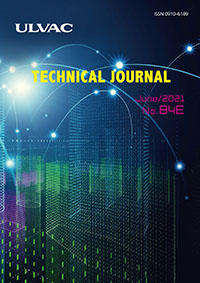
No.84E
June/2021
-
Deposition Technology for Cu Interconnect of Semiconductor DevicesDOWNLOADSatoru TAKASAWA, Kazuhiro SONODA, Kazuhiko TONARI, Masaki UEMATSU, and Yutaka KOKAZE
We have developed pre-treatment, Cu sputtering, and CVD-Co technologies for semiconductor Cu interconnect technology. A new remote plasma process in the pre-treatment technology suppressed damage to low-k films, and uniformity in the wafer surface and stability of continuous treatment were obtained. The new CVD-Co process enabled uniform film formation at a film thickness of 1.5 nm and resulted in good step coverage performance in a fine pattern. In the future, we expect that these interconnect formation technologies will be applied in logic and memory devices.
-
Development of Deposition Technologies and Processes for Phase Change MemoryDOWNLOADTakeshi MASUDA and Takehito JIMBO
Phase change random access memory (PCRAM) is a type of non-volatile memory that is embedded in semiconductor devices and has been put to practical use as storage class memory (SCM) with high speed and large capacity at a lower cost than DRAM. It is also expected to be applied to neural computing, which mimics the neural circuits of the human brain.
In order to realize PCRAM, it is essential to develop film deposition technologies and processes to realize appropriate film properties and mass productivity for memory elements, selector elements, and electrode materials (carbon is widely used). In this paper, we will explain the status of technology development for depositing each of these elements, and also present the evaluation results of a prototype AI device using CVD technology for applications in neural computing. -
Development of Sputtering System ULDiS-1500PHL for Optical Film DepositionDOWNLOADTakuma ARAYA, Tetsushi FUJINAGA, Motoshi KOBAYASHI, Yoshitaka GOUSHI, Harunori IWAI, Hungchun PENG, Szuhsun CHENG, Huang-Choung CHANG
Optical films can select transmittance and reflectance at certain wavelengths by a combination of thin films with different refractive indices. Such films have long been used as anti-reflection (AR) films, specific wavelength transmission filters, and so on. In the past, optical films were deposited on certain substrates and assembled with electronic devices. However, with the miniaturization of electronic devices, it has recently become more common to assemble optical films on wafers and electronic devices before dicing. As a result, a deposition system for optical films is required to allow wafer processing and particle control at the semiconductor level. We developed a sputtering system, ULDiS-1500PHL, for wafers, and present a system and process especially for infrared band pass filters.
-
Development of High Mobility Oxide Semiconductors for Next-Generation Electronic DevicesDOWNLOADTaku HANNA, Mitsuru UENO and Motoshi KOBAYASHI
Transparent amorphous oxide semiconductors (TAOS) typified by amorphous IGZO (In-Ga-Zn-O) are promising materials for next-generation electronic devices. They can provide homogeneous and large area thin films inexpensively by using sputtering equipment for mass production. The special properties of TAOS-based devices, such as their amorphous structure, high mobility and low leak current, may have the potential to replace conventional Si-based technology. Development of new TAOS materials which have high mobility and high reliability is essential for oxide-based technology to become widespread. In this paper we describe Target H, which we developed as a high mobility oxide semiconductor sputtering target. A thin film deposited by DC (direct current) magnetron sputtering shows high Hall mobility above 25 cm2/Vs and an amorphous structure regardless of the partial pressure of oxygen during film deposition. BCE-type TFTs (thin film transistor) using Target H and IGZO were demonstrated. The estimated mobility of Target H was 34.8 cm2/Vs, which is 3 times greater than that of IGZO.
-
Low-damage Dry Etching Technologies for GaN Power DevicesDOWNLOADShinji YAMADA and Toshiyuki NAKAMURA
Presented in this report are low-damage dry etching technologies for Gallium nitride (GaN) power devices using inductively coupled plasma reactive ion etching (ICP-RIE) equipment with a newly-developed high-frequency RF power supply. GaN vertical trench-gate metal-oxide-semiconductor field-effect transistors (MOSFETs) are promising devices for realizing high-breakdown voltage and low on-resistance. However, generally, when a trench-gate structure is fabricated by ICP-RIE, these properties degrade due to plasma-induced damage which is formed near the GaN surface. Our RF power supply contributes to the reduction of this damage by outputting accurately-controlled and ultimately-low bias power. This report introduces an overview of the RF power supply and recent achievements using the same
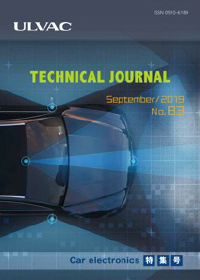 Car Electronics
Car Electronics
No.83E
January/2020
-
Manufacturing Technology for Functional Material Films for Automotive MEMS SensorsDOWNLOADTakehito JIMBO, et al., Institute of Semiconductor & Electronics Technologies
We describe in this article MEMS sensors for automotive applications and related functional material films, a deposition technology for which we have developed. The performance of automobiles is enhanced by their control systems, leading to reduced fuel consumption, higher safety, and other advantages. A MEMS sensor is an essential component of a control system because it can detect environmental changes and feed this information back to the system. The importance of automotive MEMS sensors is increasing due to the design requirements for nextgeneration automobiles, such as self-driving and all-electric vehicles. It is anticipated that by applying a variety of functional materials, a MEMS sensor with new functions will be realized. More specifically, this article introduces the PZT and VOx functional material films that have been developed by the authors. Both films are deposited by the sputtering method, demonstrating that films characterized by excellent performance can be obtained by applying a unique sputtering and process technology.
-
Dry Etching Technologies for 3D Sensors for AutomobilesDOWNLOADKanji FURUTA et al., Advanced Electronics Equipment Division
3D sensing devices for autonomous vehicles have seen major technical advances in recent years. Light Detection and Ranging (LiDAR) has emerged as the technology most compatible with these sensors, as it possesses characteristics that promise to enhance the functionality of autonomous driving. Vertical Cavity Surface Emitting Lasers (VCSELs) are economical and compact enough to serve as light sources for LiDAR. Dry process is the key to VCSEL fabrication. However, this fabrication method poses various challenges. To produce these devices, we have been developing a high-uniformity etching technology, along with an Interferometry End Point monitoring system. This article elaborates on the solutions we implemented to address these challenges.
-
Development of an Li Metal Anode Using a Vacuum Evaporation ProcessDOWNLOADAkihiro YOKOYAMA, et al., Institute for Super Materials
Because the market for lithium ion batteries is expected to grow rapidly, efforts are underway to develop an advanced rechargeable Li-ion battery. One approach for such a rechargeable battery that is attracting attention uses lithium metal as the anode, because the result would be a high-capacity, lightweight battery that is ideal in terms of energy density. However, in order to put a lithium metal anode into practical use, it is necessary to solve the problem of dendrites that occur during repeated cycles of charging and discharging. Other issues that need to be addressed include safety and battery life. Compared to conventional roll-press Li foil, our vacuum evaporated Li film has shown excellent cycle performance. We were also able to stabilize the active Li surface after deposition by applying a "chemical-passivation" process that we developed.
-
Vertically Aligned Carbon Nanotube Electrode and Application to a Lithium Ion CapacitorDOWNLOADYoshiaki FUKUDA, et al., Institute for Super Materials
Carbon nanotube (CNT) electrodes vertically aligned on a copper foil substrate have been fabricated by using a thermal chemical vapor deposition (CVD) method. In the electrode, superior electron conduction paths are formed over the entire electrode. The electron conduction paths are due to the fact that the CNTs are vertically aligned on the substrate with strong adhesion. Such a vertically aligned CNT electrode has been applied to a lithium-ion capacitor (LIC) as a negative electrode material. The fabricated LIC shows high energy density compared to an electric double-layer capacitor (EDLC) to which a commercially available activated carbon electrode material has been applied. This fabricated LIC also demonstrates high power density compared to an LIC to which a commercially available graphite anode has been applied.
-
Power Devices Used in Automobile TechnologyDOWNLOADAkihiko KOHRA, et al., Institute of Semiconductor & Electronics Technologies
Dramatic changes have been occurring in the automotive industry. Among the targets of technological development has been the shift to all-electric vehicle (EVs) and fuel-cell vehicles (FCVs). Batteries, motors, and power devices represent the most essential technologies for EVs and FCVs. A power device is a semiconductor element that functions as a switch for converting the electric power. Examples include metal oxide semiconductor field effect transistors (MOSFETs) and insulated gate bipolar transistors (IGBTs). Power device technology is currently based primarily on silicon (Si) wafers. Silicon carbide (SiC) and gallium nitride (GaN) are gaining attention as next-generation alternatives due to their high voltage resistant property with low electric resistance, which is well suited to power devices. ULVAC is working on productivity enhancement for thin Si wafer processing equipment, ion implantation equipment for SiC, and process development of activating annealing to form a p-type region in GaN power devices based on magnesium (Mg) ion implantation.
-
Industrial Furnaces for Magnets for Vehicle MotorsDOWNLOADShogo MOTEKI, Industrial Equipment Division
Magnets are produced by means of many processes, such as the alloy production process, hydrogen embrittlement process, sintering process, and grain boundary diffusion process. To produce the highperformance magnets required for use in vehicle motors, ULVAC provides an appropriate furnace for each process. The "Magcaster‑600" is a melting furnace for the alloy production process for producing magnets with good grinding characteristics. The "FHH series" includes hydrogen furnaces for the hydrogen embrittlement process without exposure to the air. The "FSC series" provides inline-type heat treatment furnaces for the sintering and aging processes. The "Magrise series" features heat treatment furnaces for the grain boundary diffusion process used to defuse heavy rare metals into neodymium. This article introduces the features of the line of furnaces manufactured by ULVAC for the production of magnets for installation in vehicle motors.
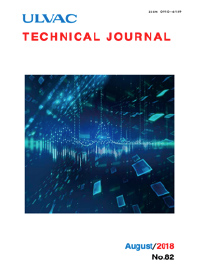
No.82E
January/2019
-
Development of a Wet Rinse Unit-Equipped Dry Etcher for Metal ProcessesDOWNLOADKenji KOMURO, et al., Advanced Electronics Equipment Division
With our dry etching equipment, high density plasma (5E10-1E11/cm3) can be generated at low pressure (0.07-13.3 Pa) by ISM (Inductive Super Magnetron) type plasma source, making it possible to achieve a uniform etching distribution using a magnet. In this issue, we developed dry and wet composite mass production type dry etching equipment for high quality SAW filters. A crucial feature of this device is that it is equipped with hardware that performs a combination of dry etch and wet etch processes in a low dew point environment to reduce the corrosion that is particularly likely to occur in composite metal films.
-
Development of a Cu Alloy Sputtering TargetDOWNLOADSatoru TAKASAWA et al., Institute of Super Material
We have developed Cu alloy films with good adhesion to glass and resin substrates. For flat panel display (FPD) applications, particularly wiring material of the next generation high definition TV, high thermal resistance is required. Compared with the Cu/Ti and Cu/Mo films commonly used as thin film transistor (TFT) wiring metals, our newly developed the Cu alloy exhibits higher thermal resistance characteristics. In addition, for printed circuit board (PCB) applications, the new Cu alloy film contributes to cost reduction by simplifying the etching process compared with Cu/Ti film as the general wiring material.
-
Research on In-plane Thermoelectric Elements Using the Spin Seebeck EffectDOWNLOADTatsuhiro NOZUE, et al., Future Technology Research Laboratory
We have investigated the thermoelectric elements using the spin Seebeck effect (SSE), in order to develop the novel thermoelectric device. The multilayered SSE elements of Y3Fe5O12 (YIG) and Pt, [YIG/Pt]n, were fabricated by sputtering. The sample of n = 2 had the SSE coefficient 2 times as large as that of n=1. However, the SSE of n = 3 sample was almost equal to that of n = 2. This enhancement of SSE is considered to be contributed by the spin current enhanced in the multilayer [YIG/Pt]n.
-
Development of Niobium Nitride Thin Film for Next-Generation Superconducting Acceleration CavitiesDOWNLOADRyohei ITO, et al., Future Technology Research Laboratory
S-I-S (superconductor-insulator-superconductor) multilayered structure theory has been proposed to achieve the maximum acceleration gradient of superconducting radio frequency cavities higher than the theoretical limit of conventional Nb cavities. In order to demonstrate this theory, we investigated the optimal deposition condition for reactive sputtering of NbN-SiO2 thin films and the correlation between the deposition conditions and the thin film properties. We finally made a multilayered sample consisting of NbN-SiO2 thin films and bulk Nb substrate, which has good crystalline orientation. Moreover, we clarified that the lower critical field of the multilayered sample was higher than a bulk Nb. In other words, we succeeded in demonstrating the S-I-S theory for the first time using a small sample size for measurement purposes.
-
"LS Series" Dry Vacuum Pumps with High Pumping Speed and Low Power ConsumptionDOWNLOADTomonari TANAKA, et al., Research & Development
Dry vacuum pumps are used in many production lines, including those for electronic parts and displays. Environmental concerns have led to dry vacuum pumps becoming mainstream thanks to their low power consumption. However, typical dry vacuum pumps with low power consumption tend to have the problem of long pumping down time, since they have a low pumping speed near atmospheric pressure. To solve this problem, ULVAC has developed a new dry vacuum pump series called the LS series that combines high pumping speed with low power consumption. By increasing the pumping speed near atmospheric pressure, ULVAC has realized a dry vacuum pump with high pumping speed that uses the innovative technology developed by the company to reduce power consumption.
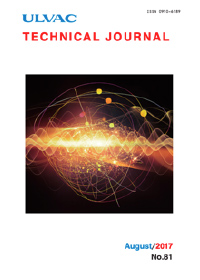
No.81E
January/2018
-
Development of Sputtering system" SMD3400" For G10.5 mother glassDOWNLOADYuusuke MIZUNO, et al., Institute for Super Material
"SMD 3400" is the large-scaled sputtering system, manufactured and developed for use in Generation 10.5 (G10.5), which mother glass size is approximately 3400×3000 mm, for TFT-LCD production line. "SMD 3400" is composed of Loading/ Unloading position, Loading/Unloading chamber, heating chamber and 2 sputtering chambers. Planer targets of Cu and ITO are mounted respectively on the sputtering chamber in multi-cathode systems. This sputtering system has improved horizontal wave-formed thickness uniformity problem depends on the cathode arrangement by using new-type deposition method, although conventionally film thickness become thicker right in front of the target and thinner at between the targets. This new-type deposition method has successfully introduced to "SMD2400"so far, which established mass production technology to improve luminance unevenness in display due to horizontal wave-formed thickness uniformity. We investigated film thickness uniformity, Rs uniformity, reflectance (for Cu), transmittance (for ITO) and film stress in the Cu and ITO process using "SMD3400". We obtained film thickness uniformity less than 10% in both process as we expected by the simulation. We confirmed new-type deposition method improve Rs horizontal distribution. And good Rs uniformity, reflectance, transmittance and film stress were obtained at G10.5 substrate area.
-
Development of High Resistivity Transparent Conductive Oxide Electrode using Sputtering ProcessDOWNLOADHirohisa TAKAHASHI et al., Institute of Super Material
For the In-Cell type touch screen panel, a high resistivity transparent electrode that can work as anti-static without affecting touch sensing is required. ULVAC selected Sputtering Process which is high in productivity and suitable for large size and successfully developed a high resistivity transparent conductive oxide electrode satisfying required specification.
-
The printed circuit manufacturing using the nano metal ink and fabrication of transparent fine electrodes by gravure offset printingDOWNLOADNatsuki HASHIMOTO, et al., Future Technology Research Laboratory
We introduce silver nanoparticle ink, namely nanometal ink, which is essential for printed electronics. In recent, flexibility is required in the field of transparent electrodes for future flexible devices. Although indium tin oxide (ITO) is the most widespread material as transparent electrode, its lack of adequate flexibility and poor conductivity restrain from further development for future devices. We have attempted to make patterns of invisible and high conductive fine silver electrodes by a gravure offset printing method to meet both of transparency and flexibility. Here, silver nanoparticle ink was developed and applied to fabricate fine invisible silver electrodes with the line width of 5 μm. The fabricated electrode pattern of which the line/space is 5 μm / 300 μm has excellent electric conductivity and transparency. The patterned electrode has sheet resistance of sub-10 Ω/ □ , while its transparency is higher than 90.
-
Crystal growth of quantum dot phosphors and their application to photoelectric conversion deviceDOWNLOADJunki NAGAKUBO, et al., Future Technology Research Laboratory
In order to obtain semiconductor quantum dots with superior opto-electronic performance, several technologies are required including epitaxial growth, fine particle size control, and ligand control. We have synthesized quantum dot phosphors via these technologies. The quantum dot phosphors showed better color purity (full width at half maximum: 45.0 nm, chromaticity coordinates: 0.177, 0.688) than conventional phosphors such as β -SiAlON. A photoelectric converter using these quantum dots has been fabricated, which shows 16.7% of external quantum efficiency at 850 nm of infrared light. The result indicates a possibility of developing superior infrared image sensor than conventional organic CMOS image sensors.
-
Development of a quartz crystal resonator with a resonance frequency of 4 MHzDOWNLOADAtsushi ITO, Components Division
A quartz crystal microbalance (QCM) is typically used to monitor the vapor deposition of organic materials, and QCM sensors feature a quartz crystal resonator with a resonance frequency of 5 or 6 MHz. When a metal or oxide film forms on a sensor, the rate at which the material adheres varies little. When an organic film forms on a sensor, however, the rate at which the material adheres varies considerably. This causes a problem since it greatly reduces the life of the quartz crystal resonator. The current work used several quartz crystal resonators with different fundamental frequencies to measure electrical and temperature characteristics during formation of an organic film. Results indicated that a quartz cr ystal resonator with a resonance frequency of 4 MHz or lower was better suited to sensing vapor deposition of an organic material than a resonator with a resonance frequency of 5 or 6 MHz.
-
Advanced Spectra Interpretation in TOF-SIMS" Parallel Imaging MS/MS"DOWNLOADShin-ichi IIDA, et al., ULVAC-PHI, INC.
Recently, the applications of TOF-SIMS have expanded into a wide variety of organic materials, because the sensitivity of high mass molecular ions was improved dramatically. However, it was very difficult to determine the chemical formula from the measured mass above m/z 200. The ambiguous peak identification was a significant problem in TOF-SIMS. In order to determine the chemical formula as well as detailed chemical structure, we developed the TOF-SIMS instrument equipped with Tandem MS (MS/MS), and applied it to analysis of various organic materials. In this article, we will introduce this unique instrument, and demonstrate the results of the spectra analysis using MS/MS.
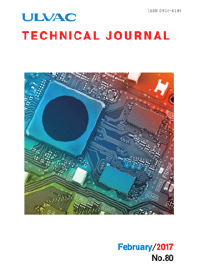
No.80E
April/2017
-
High-density Panel Level Package SolutionDOWNLOADYasuhiro MORIKAWA, et al., Institute of Semiconductor and Electronics Technologies
High-density packaging technologies such as 3D, 2.5/2.1D scheme basing on PCB (Print Circuit Board) substrate are among key technologies to satisfy the requirements from the both smart semiconductor devices and smart functional devices. ULVAC has been continuously developing manufacturing solutions for high-density packaging. In this paper, buildup multilayer technology solutions consisting of etching, ashing and PVD (Physical Vapor Deposition) sputtering to make the high density interconnection PCB panel substrate, will be introduced.
-
Recent Developments in MRAM Mass-Production Technology in ULVACDOWNLOADHiroki YAMAMOTO et al., Institute of Semiconductor and Electronics Technologies
We have been developing sputtering tool for MRAM mass production, with simple module configuration and smaller footprint. It provides stable magnetic Co films and low damage MgO film with RA uniformity of 3.5%. Novel wide temperature process from -170℃ to 600℃ to fabricate excellent MTJ layers, will also be introduced.
-
Development of Niobium Superconducting CavityDOWNLOADTomohiro NAGATA, et al., Future Technology Research Laboratory
We study about Niobium refining and elliptical cavity fabrication process for superconducting cavity. In order to carry out Niobium purification, 600 kW electron beam melting furnace was introduced in our factory. It makes possible the stable refining to obtain a cavity quality grade by optimization of melting condition. We performed the trial manufacturing of two single cell cavities are made from our high purity Niobium ingots (RRR>300). Maximum accelerating voltage of weldingtype and seamless - type cavities were achieved 41 MV/m and 37 MV/m at 2K, respectively. These values surpass the specification of international linear collider project. Also, seamless tube for three cell cavity was prepared as scale up study. Because an average grain size in the tube for three cell is smaller than that for single cell, it is expected that smoother surface is obtained after hydrofroming process.
-
Hot Cathode Ionization Gauge "G-TRAN series ST2" Obtained High Stability and Long LifeDOWNLOADToyoaki NAKAJIMA, et al., Components Division
Because of changes in the operating environment and the material processing with the vacuum equipment, lowering and fluctuation of the reading value of the ionization vacuum gauge has increased. Therefore, we focused on the triode ionization vacuum gauge that has a feature of high stability and high accuracy, we developed the world's first small metal type gauge head of triode ionization vacuum gauge. In environments such as oil is deposited, it was confirmed that a long period of time the reading value is more stable than the cold cathode ionization vacuum gauge and B-A ionization vacuum gauge.This triode ionization vacuum gauge that we have developed is an old technology, but we believe can contribute to solution in the new market.
-
Introduction Of Liquid Nitrogen Generator" EMP Series" and New Product" UMP-40W"DOWNLOADChiaki HAYASAKA, et al., Cryogenic Equipment Engineering Divison, Ulvac Cryogenics Inc.
ULVAC CRYOGENICS INCORPORATED (UCI) has been a leading provider of cryopumps, and on May 2014, it has been transferred the technology of cryocooler applied equipments from IWATANI INDUSTRIAL GASES CORPORATION (IIG). Now UCI has successfully fused its existing cryocooler and liquid nitrogen generator from IIG into new liquid nitrogen generator," UMP-40W". UCI now plans to actively promote sales of" UMP-40W" globally. We will discuss in detail the transfer of technology.
-
New application fields developed by Hard X-ray Photoelectron Spectroscopy:"PHI Quantes"DOWNLOADKatsumi WATANABE, et al., Department of Research and Development, ULVAC-PHI, INC.
A newly developed "PHI Quantes" is introduced, which enables both XPS(X-ray Photoelectron Spectroscopy) and HAXPES(Hard X-ray Photoelectron Spectroscopy) by using Al Kα and Cr Kα, respectively. HAXPES has advantages comparing with ordinary XPS, such as deeper analysis depth to several 10 nm, surface contamination free analysis, nondestructive interface analysis and chemical state analysis by measuring inner shell electron. Some latest applications are also demonstrated to show the capability of " PHI Quantes"..